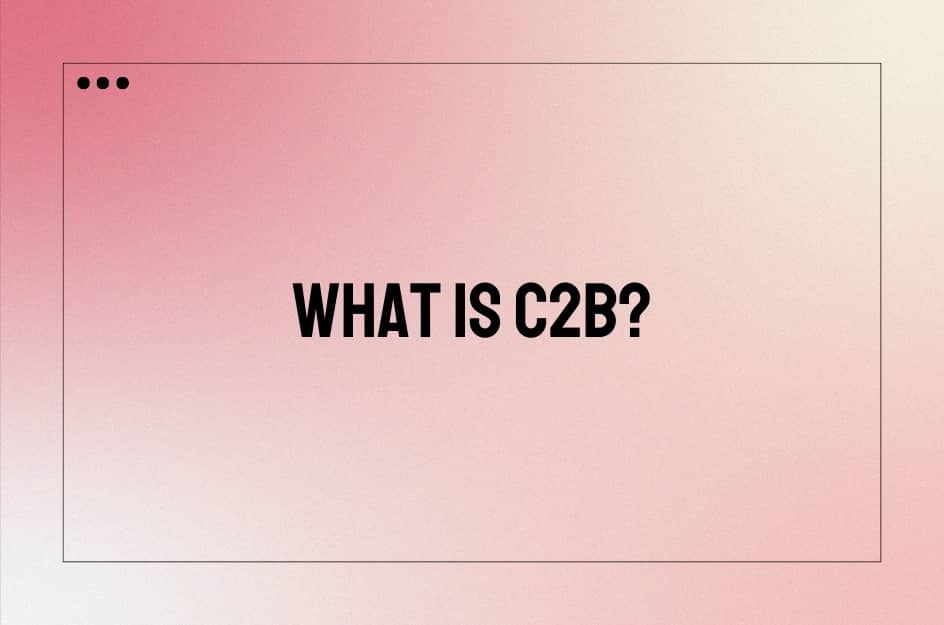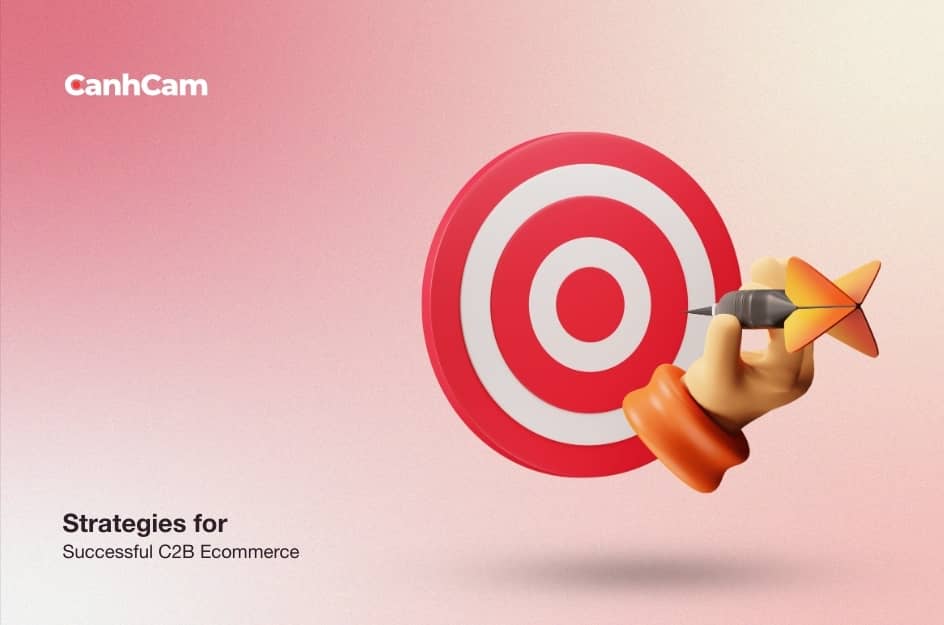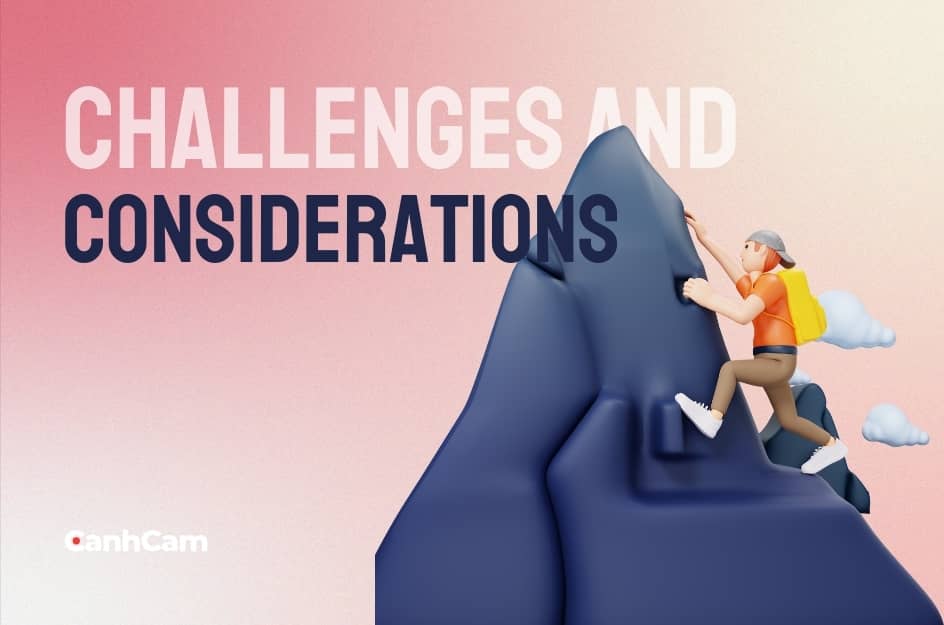The consumer-to-business (C2B) ecommerce model is a new way for consumers and businesses to interact, creating mutually beneficial relationships. In this model, consumers are no longer passive recipients but active value creators that organizations can leverage for business processes or a competitive edge.
Understanding the intricacies of C2B is crucial for businesses looking for sustainable growth in the digital age. This article will explore the details of C2B, providing examples, benefits, and comparisons with other models. By examining this evolving concept, we can demonstrate how it reshapes consumer-business interactions for mutual benefit.
What is C2B E commerce?
C2B which means (Consumer to Business) refers to commercial exchanges carried out by the consumer for the company. Customers therefore provide products, services, or solutions on behalf of a company.
This type of business model, which puts a consumer in contact with a company and is opposed to the traditional B2C (Business to Consumer), can generate remuneration from the company but this is not always the case. These new relationships between consumers and businesses have become possible thanks to the advent of the Internet and social networks.
Visit our services: affordable websites design melbourne
Digital and new information and communication technologies (NICT) allow professionals to easily contact consumers and establish new commercial relationships.

Several types of activities fall within the framework of C2B (Consumer to Business), this is for example the case of:
- Writing reviews and testimonials from consumers: they are generally posted on social networks, websites, etc., and may in certain cases be subject to payment or the sending of a reward (gift, reduction voucher, etc.)
- Crowdsourcing (participatory production): the company creates products, services, or communication campaigns in collaboration with consumers for remuneration or not.
- Participation in surveys: they can be paid or unpaid and allow professionals to collect opinions in order to develop a new product, a new marketing strategy, etc.
- Consumer reviews and testimonials play an essential role in C2B. In practice, this can be translated in different ways beyond the simple publication of notices.
- Indeed, it could be a blogger who posts an article on a particular product, a consumer who sends detailed product feedback after receiving samples, or a YouTube influencer who makes an unboxing video.
The development of C2B is closely linked to the Internet and social networks. The relationship between consumers and brands is facilitated, which allows individuals to regain power.
They are more involved in the design of products and services sold on the market. An approach that makes it possible to market products and services that are ever more personalized and in line with consumer expectations.
Read more: BOPIS Ecommerce - How to Buy Online to Pick up In-store?
Benefits of C2B for Businesses
Flexibility:
Businesses and sellers can define their own revenue parameters, such as the duration of services, how often payment gets collected, or product supply dates. This offers more scheduling flexibility for freelancers to enjoy while providing their services.
Higher earning potential:
Sellers have unlimited earning potential; they can work as much as they want and provide their services and products to as many businesses as they choose.

C2B in Action
Witnessing C2B in action involves exploring various interactions. From online reviews shaping purchasing decisions to user-generated content driving brand engagement, the landscape is diverse. Understanding these dynamics is crucial for businesses navigating the digital marketplace.
Comparing C2B to Other Models
To comprehend the uniqueness of C2B, it's essential to compare it to other models like B2B, B2C, C2C, B2G, and C2G. Each model has distinct characteristics, and discerning these differences is vital for businesses tailoring their strategies effectively.
The Mechanics of C2B
Delving into the mechanics of C2B transactions unveils the flow of value from consumers to businesses. This reciprocal process defines the essence of C2B, emphasizing the active role consumers play in shaping the market.
C2B vs B2C: Know the Difference
Consumer-to-business and business-to-consumer are two different business models that are sometimes a source of confusion for readers. That is why we are going to discover their main characteristics to clearly understand this difference.
C2B is a business model in which a consumer becomes a supplier of products or services for a certain company. Often, this person has the talent and tools that can help promote someone's business. The company pays this customer a certain amount of money for the services rendered. These services include:
- Write reviews or product reviews on their blog or website;
- Share posts on social media;
- Create photos and videos.
The main objective is to connect with people and effectively promote and sell the brand's product.
B2C is a business model in which companies sell directly to consumers. In this case, a company does not need a mediator. Customers can visit a company's website, choose a needed product, and have it delivered within days or weeks. The B2C model has many advantages. It helps customers in remote areas purchase the products they need online at a lower cost.
C2B: The Good, the Bad
Embracing C2B comes with its set of advantages and challenges. Scalability and cost-effectiveness are clear benefits, but businesses must also address quality control and manage large user bases. Balancing these aspects is crucial for success.
What are the follow and avoid of C2B?
Ensuring successful C2B engagement requires adherence to best practices. Building trust and encouraging participation are paramount while neglecting user feedback and presenting an unclear value proposition are pitfalls to avoid.
Making C2B Work for You
Strategizing for a successful C2B model involves understanding the unique dynamics of this ecommerce approach. Implementing effective strategies ensures businesses harness the full potential of C2B interactions.
Strategies for Successful C2B Ecommerce
Building Trust and Transparency
Establishing trust is foundational in C2B ecommerce. Transparency in operations and clear communication build a robust foundation for consumer-business relationships.
Leveraging User-Generated Content
Harnessing the power of user-generated content amplifies brand engagement. Encouraging consumers to share their experiences and opinions contributes to a vibrant online community.
Providing Seamless Transaction Experiences
Simplifying transaction processes enhances user satisfaction. From intuitive interfaces to secure payment gateways, prioritizing seamless experiences fosters customer loyalty.

Challenges and Considerations
Data Privacy and Security
Protecting consumer data is paramount. Implementing robust data privacy and security measures builds trust and compliance.
Managing Customer Feedback and Reviews
Effectively managing feedback and reviews, both positive and negative, is crucial for maintaining a positive brand image. Responding thoughtfully demonstrates a commitment to customer satisfaction.
Addressing Technological Barriers
Staying ahead in C2B ecommerce requires addressing technological challenges. Businesses must adapt to emerging technologies to ensure a seamless online experience.

Frequently Asked Questions (FAQs)
1. What are examples of C2B companies?
Companies such as Upwork, Fiverr or Scripted exist due to the feature that freelancers can directly match their skills with potential employers and the needs of businesses for quick completion of concise tasks. Upwork and Fiverr wouldn't exist without the customer's supply (freelancers' services) and businesses' demand.
2. How does C2B ecommerce work?
In the C2B commerce, consumers generally have direct links to businesses with the help of online platforms or marketplaces. These include freelance activities, customized things, user-generated content, and business entities, which will be the ones responsible for the funding.
Conclusion
In conclusion, C2B ecommerce marks a transformative era in digital commerce. Navigating this landscape requires an understanding of its mechanics, proactive strategies, and a commitment to building meaningful consumer-business relationships. As the digital marketplace evolves, businesses embracing C2B stand to redefine success.

